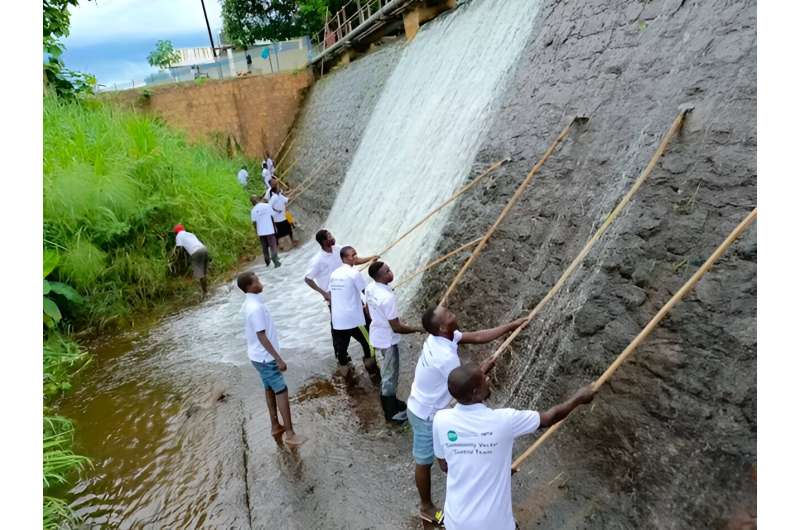This article has been reviewed according to Science X's editorial process and policies. Editors have highlighted the following attributes while ensuring the content's credibility:
fact-checked
trusted source
written by researcher(s)
proofread
Beating river blindness: Blackfly bites dramatically reduced after breeding sites destroyed with machetes

Onchocerciasis, commonly known as river blindness, is a neglected tropical disease that causes severe itching, disfiguring skin conditions and visual impairment.
It can lead to permanent blindness and there is strong evidence that onchocerciasis directly or indirectly induces epilepsy.
As a neglected tropical disease, river blindness is listed among a diverse group of conditions caused by a variety of pathogens and associated with devastating health, social and economic consequences.
These diseases are mainly prevalent among impoverished communities in tropical areas.
According to the most recent estimates, there are more than 18 million people infected with onchocerciasis worldwide, with 99% living in sub-Saharan Africa.
In Cameroon and South Sudan respectively, 11 million and 9 million people are at risk of onchocerciasis infection.
8,000 bites each day
The parasite worm Onchocerca volvulus that causes onchocerciasis is transmitted to humans through exposure to repeated bites of infected blackflies of the genus Simulium. The parasite can live in the body for up to 15 years.
In the early 1990s, a study of the insects and their relationship to humans, the environment and other organisms revealed extremely high blackfly bite rates in Cameroon, with 8,000 bites per person each day in some sites.
Treating and preventing river blindness
River blindness is usually treated with the drug ivermectin, which kills the skin-based parasites in infected people.
However, eliminating onchocerciasis using ivermectin treatment alone would be difficult as it would require treating 80% or more of the population in endemic communities annually for at least 15 years.
One alternative—vector control—consists of reducing blackfly bites to limit the spread of the parasite. Various methods have been used in the past to prevent blackfly bites, including rubbing kerosene or lemon onto the skin. People have also used chemical insecticides such as dichloro-diphenyl-trichloroethane (DDT), the toxic insecticide that is banned in many parts of the world.
As researchers who study global health, we have been working on ways to combat onchocerciasis in endemic hotspots. We conducted two studies in Cameroon and South Sudan using "slash and clear," an eco-friendly method that eliminates the need to use dangerous chemicals.
A new approach
We decided to test a "slash and clear" approach: destroying the blackfly breeding sites using machetes.
In our latest study, in Cameroon, we first had to find where these insects bred, usually along fast-flowing rivers, where the developing forms or larvae of the blackflies thrive on plant material like leaves, tree trunks or algae-covered rocks before emerging as adult biting insects.
Blackflies can live for a few weeks so the effects of the "slash and clear" method were seen within a few weeks when the adult blackflies already in circulation had all died.
Villagers play a part
One of the aims of the study was to explore whether residents of onchocerciasis-affected villages would be willing to use the "slash and clear" technique, which takes place every six months.
In the Ntui district in the Center Region of Cameroon, home to about 25,000 people, community volunteers from two villages were trained in the "slash and clear" method at blackfly breeding sites closest to their villages.
Six volunteers from each village were taken to the river and taught how to recognize potential breeding sites. They were also provided with machetes, gardening gloves, and life jackets to make sure they were safe. The trained volunteers were tasked with trimming the leaves and tree branches that were immersed in the fast-flowing water segments. They also scraped off any algae on rocks which could harbor blackfly larvae.
This activity saw a 50% reduction in the blackfly biting rate, estimating the number of bites per hour using the human landing catch technique validated by the World Health Organization.
Trained catchers are posted at the river banks near the breeding site and tasked with capturing all the blackflies that landed on them using tubes. The biting rate is calculated by the number of blackflies caught in an hour.
At the end of the study, communities were eager to keep up blackfly control provided volunteers were given the right equipment to do the clearing.
The South Sudan experiment
We did an earlier, longer experiment in South Sudan.
After three years of six-monthly "slash and clear" exercises, there was a 90% reduction in blackfly bites.
Another positive outcome was that after three years, fewer 3-year-olds tested positive for onchocerciasis antibodies, with a reduction from 12.5% before the project to 8.8% afterwards.
There was also a significant drop in new epilepsy cases.
Communities continued to use the "slash and clear" method after the study ended, and it is still conducted every six months.
Looking forward
The "slash and clear" intervention is an effective, eco-friendly and widely accepted solution to the problem of blackflies in onchocerciasis-endemic communities.
It also improves quality of life by reducing the nuisance caused by painful blackfly bites.
Hopefully this method can be scaled up to other endemic sites to eliminate onchocerciasis once and for all.
This article is republished from The Conversation under a Creative Commons license. Read the original article.![]()
















